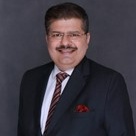Creating a new way of working with Adaptable HR

20-odd years ago, no one could have predicted that businesses would morph into the full digital technology ecosystems that they are today. And yet, here we are in an ever-evolving world of work that is virtual yet human. Today, organisational success is no longer about digitalisation, but the ability to collect, understand, and leverage the data produced within the digital ecosystem.
From a HR standpoint, we are now in the era of Adaptable HR, and this story takes a look at what that means and how we got here.
Pre-2000: The ‘Stone Age’ of HR
HR was broadly administrative in its scope. Very few organisations valued the strategic potential of HR, and most HR tech decisions were made by other parts of the organisation. But the floodgates of worldwide digital connectivity were opening, and globalisation and scale drove businesses to think for the first time about HR delivery. This led to some investment in tech, and the emergence of outsourcing HR.
2000-2005: War for Talent
A fairly active period during which the “War for Talent” became a recognised paradigm.
A study, “Next Generation HR: People, Performance, Results” (Hewitt Consulting), conducted with 500 CEOs on what value they need from HR revealed telling results that are still relevant today. The findings led to the idea of Next Gen HR. Focus shifted to an outcome-driven HR, the larger set of experiences and culture that employees are embedded in, and analytics. Thought of by many global and APAC businesses as too advanced at the time, this is par for the course in today’s context.
2010: Global HR Strategy
In the wake of the global financial crisis of 2008, another study, “Managing HR on a Global Scale” (Hewitt Consulting), was conducted to understand what it means to run a global HR function, how strategy is managed, and what success looks like. It found that “global HR strategy” is a misnomer, and what HR teams could really on do was calibrate their strategy for global scale.
The study showed that the HR operating model of a successful business is about four interconnected disciplines moving in sync: Programmes, HR Organisation, HR Tech, and Governance (which includes analytics). Tweaking one will require a tweak in the others to get desired outcomes. This remains a key discipline in making organisational change happen.
2015: Refresh and Reboot HR
Markets were connected like never before by this point. In Asia, the thrust was toward mobile, and global vendors were not keeping up. Businesses were looking at agility, speed, and innovation, and workforces were looking at experience, transparency, and purpose. The main challenge was thus getting HR leadership to welcome the new ways of working. In most cases, business leaders were impatient and took a lead in driving this change.
2016-2017: Always on HR
As experience became central, “HR Service Delivery” strategy was key to digital success. It was about using technology with an updated operating model to be always there for your workforce, or in other words, an “Always on HR”.
2018-2019: Low Effort, High Impact
Experience was still central, and the biggest challenge was syncing HR services strategy with HR tech strategy. Most successful organisations with discipline in delivery were using levers of automation, personalisation, and reduction in errors to create leaner HR operations. These organisations demonstrated that most successful HR functions need lower bandwidth in transactive HR, freeing them up for strategic impact. This created the archetype of Low Effort, High Impact HR.
How to understand and succeed with digital HR
Through several discussions among consultants, the need to understand the changes for HR, the outcomes demanded, and what would lead to success in execution led to the 3-3-3 model for digital success, which was presented in the “State of HR Transformation 2020 Study” (Alight).
This simplified model serves as a map of a broader HR transformation journey which is anchored to the success of digital HR initiatives.

2020 and beyond: Adaptable HR
Changes in business proceed at pace and demands from HR are accelerating and creating the need for “Adaptable HR”. Adaptable HR is, in principle, a way of working which enables HR to thrive in a world of constant change while creating a competitive advantage for the business. Although this started prior to COVID, it really came into the spotlight because of COVID.

“Organisations that adopted Adaptable HR did better on HR outcomes and enabling impact for the whole business.” – Shaswat Kumar, SVP of Global Customer Success and Delivery, Darwinbox.
From the responses of businesses during COVID times and their ability to pivot from there, it was found that organisations that adopted Adaptable HR did better on HR outcomes and enabling impact for the whole business. These organisations have a distinct advantage as businesses pivot forward and define their Work from Anywhere (WFA) strategy and accelerate talent acquisition.
Research shows that organisations with an Adaptable HR function have 22x the net promoter score (NPS) on technology satisfaction compared to the market average, and are 3x more likely to succeed in delivering a closer partnership with the business. They are also 1.7x more productive.
Taking the findings of the last 20 years, Adaptable HR is the confluence of governance, experience, and design to drive value for HR stakeholders. This is what enables HR to deliver on its commitment to outcomes, adoption of technology for completeness of design, and constant calibration to solve challenges now and in future.
In conclusion
The world will continue to see change and disruption to the status quo, and business leaders will look to HR to respond and win in this fluid environment. But Adaptable HR is not only for HR—it creates a whole culture, a new way of working for everyone in the organisation.
The organisations that get this right are typically ambitious but humble to learn. They know that success lies in a partnership between the business side and HR side of the organisation, and they leverage HR technology to drive that success. They use data to co-create a design and experience with their end-users. It is these organisations with ‘Adaptable HR’ at their heat that will lead the way in the new decade.
By Shaswat Kumar, SVP of Global Customer Success and Delivery at Darwinbox.



